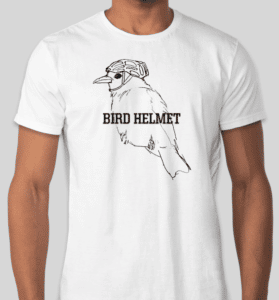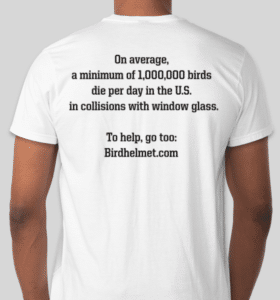Maine Audubon and the Maine College of Art (MECA) have partnered for several years on a class called Mathematical Enterprise, where students learn to develop grant proposals and present their ideas to simulated grant panels. Maine Audubon presents the students with a topic, and the students develop solutions, build a budget, and make their pitch for funding.
This year the topic was Bird Safe buildings, a real-world problem that Maine Audubon and others are tackling in Portland and around the state. Between 365 million and one billion birds die each year in the United States after colliding with buildings, making it one of the leading causes of bird mortality. But, thankfully, there are solutions, including ways to make glass more visible to birds.
The students dove in, and their resulting projects were fascinating. The projects highlighted both the creativity of the students as well as the complexity of the problem. Professor Bob Jenkins captured the video below, and you can watch the student’s presentations for yourselves (except for the first one, which begins mid-presentation due to technical issues).
The first group, calling themselves Junco Jeans, came up with a very innovative technology to make glass more visible to birds. Their proposal would outfit windows with motion detectors that could sense an incoming bird, and then trigger electrochromatic film, which turns the window from clear to solid-looking. Once the bird flies away safely the window reverts to clear. Genius!
 The second group, Puffins, designed a series of outreach and educational materials that could be placed around the city to raise awareness among the public, meeting a huge real-world need. Their posters and decals could be placed on target buildings and would include links back to an educational website.
The second group, Puffins, designed a series of outreach and educational materials that could be placed around the city to raise awareness among the public, meeting a huge real-world need. Their posters and decals could be placed on target buildings and would include links back to an educational website.
Team Paint Paints came up with another outreach idea, this time based around humor: what if we protected birds by giving them helmets to wear? The resulting silliness is intended to get the viewer thinking about the problem as well as more realistic solutions. The team envisioned t-shirts (as shown below), public service announcements, posters, and other outreach, all connected back to a central educational website.


The Night Owls also came up with an outreach presentation based around posters, murals, social media, and other tools. They included a strong sense of metrics, grounding their proposal in the real-world need to assure granters that their work is reaching the public.
Finally, Team No Name took the problem to the youth, designing a high school curriculum around bird safe education. The team developed worksheets for students, educational videos, and kits for students to monitor bird strikes at their own schools or homes. Today’s youth can be very effective advocates for change, but not if they don’t know about the problem. Team No Name thought that introducing the problem to high schoolers would help develop a broad base of understanding.
In the end, the panel of judges was unable to award the fake grant to just one team, and instead split it among each. The ingenuity and creativity displayed by the Maine College of Arts students was once again refreshing, and Maine Audubon is excited to continue our partnership into the future.
